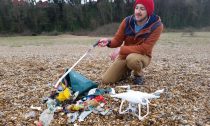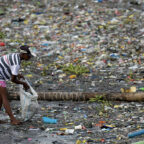
An environmental organization in England is using drones and artificial intelligence to help measure plastic waste on the world’s beaches. In the last 10 years, there has been a 250% increase of plastics washing up on the world’s beaches. Of the millions of tons that are dumped in our oceans each year, we can only account for around 1%. The rest – yes, that’s 99% of millions of tons – is missing, lost among the waves. That’s the startling introduction from The Plastic Tide founder Peter Kohler.
Having the noble intention of cleaning up the mess we have made is just the start. The scale of that task is monumental. Aside from all the plastic floating around in the oceans and on the sea floor, spotting the waste that does turn up on beaches among pebbles and sand isn’t easy.
In an interview with DJI, The Plastic Tide outlined how they have been using a combination of drones and machine learning to identify and measure the amount of plastic waste on beaches. Eventually, the technology could develop into an automated aerial system, capable of guiding cleanup efforts and tracking their progress.
Penning an article for DJI, founder Peter Kohler explains how he started using drones as part of his ambition to explain and understand the spread of plastic waste across our oceans. The main challenge was surveying beaches and collecting data in a way that was fast, cheap and effective.
“Then it struck me,” he writes. “I could use drones! I had already seen the potential for drones in everything from filming to disaster relief. Cost effective, lightweight, quick to deploy, with powerful cameras and the ability to cover relatively large areas in minutes rather than hours. It seemed to be a great solution to the surveying problem.”
But drone imagery alone isn’t enough to quantify and recognize plastic waste, particularly in such a uniform environment.
“It seemed like I needed a system that could learn what litter looked like, but I had no idea how to build that.”
It was in 2016 that Kohler began working with machine learning expert Dirk Gorissen. “To train the AI, we would need a large amount of images with litter tagged to teach the algorithm to find the plastics. This would mean a big exercise surveying as many different kinds of beaches as possible with a drone.”
The team chose a DJI Phantom 4 and got to work, with a little help from community volunteers.
“Volunteers worked to tag plastics in the images. This not only trained our algorithm, we found that many users reported that the process had made them much more aware of litter in the environment in general. We gathered 14,000 images from beaches across the UK and to date have collected of 4 million tags from over 10,000 volunteers – a humbling number!”
The great thing about machine learning algorithms is that they can get smarter. The more data they are fed, the better they become at recognizing images.
So in the short term, The Plastic Tide wants to use the technology to support and coordinate beach cleaning efforts.
In the long term, Kohler writes, “we can target specific campaigns and policies to prevent our oceans from being polluted in the first place. Alongside this, we hope to share what we learn through this project, working to educate and engage the public in the importance of recycling.”
The charity plans to complete a number of trials along coastlines this year, based on images gathered from their drone working in visible light.
But perhaps the most exciting potential brings us back to that statistic at the start, that only around 1% of the plastic waste in the oceans ends up on our beaches.
Kohler writes that the team “would like to explore the use of cutting-edge hyperspectral and multispectral imagery in combination with machine learning to extend the projects’ operational area from coastlines to the ocean’s surface and the sea floor.”
In just 5 years he wants to be operating not just on coastlines, but on the ocean floor and on the surface of the water. Everywhere the spread of plastic waste is damaging our environment.
You can read more about The Plastic Tide on their website. The full feature for DJI is here.















Social Profiles